Main content starts here.
From the Permanent Collection (2017.1.7-4.23)
7th January (Sat.) - 23rd April (Sun.), 2017
Closed on Mondays (except for 20th March), 21st March (Tue.).
Admission Fee:
Adults: 300 yen , College students: 150 yen
Elementary / Junior high school / high school students: free
Main Gallery 1, 2
About 100 pieces from the collection of the Miyagi Museum of Art are exhibited.
- Special Feature: Katsuhira Tokushi and Koseki Kimiko
- Modern and contemporary paintings in Japan
- Sunouchi Collection
- Schiele and kokoschka
- Klee and Kandinsky
Works
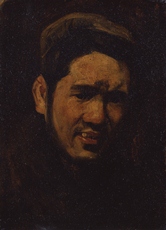
NAKAMURA Tsune, Self-Portrait, cal. 1909
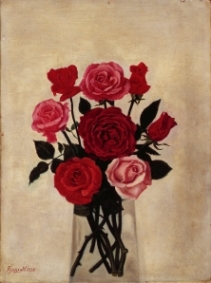
HASEGAWA Rinjiro, Roses, 1938
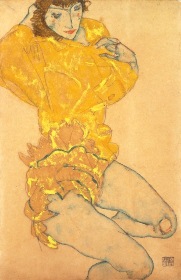
Egon SCHIELE, Woman in Yellow, 1914
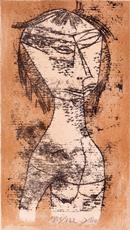
Paul KLEE, Saint of Inner Light, 1921, from ”Collected New European Prints, Portfolio 1”
Special Feature: Katsuhira Tokushi and Koseki Kimiko
A native of Akita City in Akita Prefecture, Tokushi Katsuhira (1904-1971, birth name: Tokuji) was so inspired by the works and ukiyo-e of Yumeji Takehisa that he began to teach himself about woodblock printing. “Creative print art” became popular when Katsuhira was active as an artist. Rather than dividing the work of the painter, printer and engraver, artists during this period drew, engraved and painted their own works. Katsuhira’s works were selected and put on display in many exhibitions including an exhibit by the Nihon Sosaku-hanga Kyokai (Japan Creative Print Art Association) in 1929. He was also recommended to become a member of the Nihon Sosaku-hanga Kyokai in 1932.
Katsuhira never left Akita during his lifetime as he wanted to imprint the changing scenery of Akita through his work. Despite not leaving his hometown, Katsuhira’s works were adored by fans overseas after his illustrations were included in House and People of Japan, a book written by German architect Bruno Julius Florian Taut, whom Katsuhira met and became acquaintances with when Taut visited Akita. Katsuhira had opportunities to display his works in exhibits overseas during the later years of his life. Through various media including binding, drawings, illustrated postcards and Akita wood carved dolls, Katsuhira was able to convey Akita’s culture.
Kimiko Koseki (1903-1984) was a Sendai City native artist who studied Japanese-style painting at the Joshibi University of Art and Design. In 1928, Koseki’s painting, “Returning Home from a Festival,” was selected and accepted for the Imperial Art Exhibition. Thereafter, she unwaveringly published her works at the Imperial Art Exhibition, Japan Fine Arts Exhibition and the Japanese-style Art Exhibition.
Throughout her lifetime, Koseki painted the scenes of the Tohoku Region and its people. Koseki was baptized when she was a university student, and while practicing a life of poverty similar to St. Francis of Assisi, a new style was discovered in her art integrating the scenes of the Tohoku Region and stories of Christianity together with her nostalgia and faith.
Koseki presented the Vatican Ambassador to Japan her painting, “The Nativity Scene,” which was selected as the design for the Christmas stamp issued by the Vatican in 1964. Her art showed respect for the church and the Pope, and in 1975 Koseki became the first Japanese to receive the Cross of Honour from the Pope. She continued to display her ability as an artist not because of her longing for high status, but because of her genuine passion for painting. Koseki’s main works, which included those exhibited in the Imperial Art Exhibition and Japan Fine Arts Exhibition, can be found in the hands of the Vatican and Italy.
Introducing two Tohoku Region artists from the same period who created their works from their own hearts.
Works
KATSUHIRA Tokushi,
Snow-covered Town, 1932
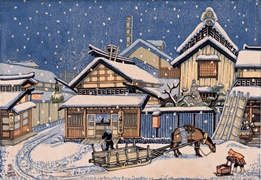
KOSEKI Kimiko,
Returning Home from a Festival, 1928
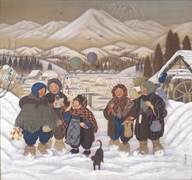
The Churyo Sato Gallery
Representative sculptures and drawings by Churyo Sato are exhibited.
Room 9 Original Illustrations for Children's Book:Hijikata Hisakatsu
The museum houses a leading collection in picture books with over 10,000 original drawings from about 530 titles.
Gallery 9 features original illustrations from picture books by various authors as well as sculptures by Churyo Sato.
For this exhibition, the gallery will show original drawings from "A Pleasant Walk" and "Piggie BUTABUTA Goes Shopping" billustrated by Hijikata Hisakatsu.
Come explore the gallery and view Churyo Sato’s many sculptures including the plaster relief, "The Turnip – An Old Russian Tale".
Works
SATO Churyo, Scops Owl, 1970
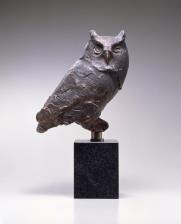
HIJIKATA Hisakatsu, Piggie BUTABUTA Goes Shopping, 1970
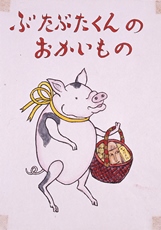
- From the Permanent Collection (2017.7.20-10.15)
- From the Permanent Collection (22nd Jan. - 5th Apr., 2020)
- From the Permanent Collection (11th Sep. - 15th Dec, 2019)
- From the Permanent Collection (17th Apr. - 30th Jun., 2019)
- From the Permanent Collection (3rd Jul. - 8th Sep., 2019)
- From the Permanent Collection (22nd Jan. - 14th Apr., 2019)
- From the Permanent Collection (23rd Jan. - 15th Apr., 2018)
- From the Permanent Collection (3rd Oct. - 24th Dec., 2018)
- From the Permanent Collection (13th Jun. - 30th Sep., 2018)
- From the Permanent Collection (17th Apr. - 10th Jun., 2018)
- From the Permanent Collection (18th Oct. - 24th Dec., 2017)
- From the Permanent Collection (2017.4.26-7.17)
- From the Permanent Collection (2017.1.7-4.23)
- From the Permanent Collection (2016.9.7-12.25)
- From the Permanent Collection (2016.7.5-9.4)
- From the Permanent Collection (2016.1.22-4.10)
- From the Permanent Collection (2016.4.12-6.19)
- From the Permanent Collection (2015.10.21-12.23)
- From the Permanent Collection (2015.7.29-10.18)
- From the Permanent Collection (2015.5.1-7.26)
- From the Permanent Collection (2014.9.9-12.14)
- From the Permanent Collection (2015.1.31-4.5)
- From the Permanent Collection (2014.4.15-7.6)
- From the Permanent Collection (2014.7.15-8.31)